福明菜场定位在菜市场里的美食博物馆,其复兴不只是福明文化,而是以福明菜场为舞台,复兴宁波美食文化,成为代言宁波文化的美食地标名片。
Oriented as a food museum among grocery markets, the revival of Fuming market is not only about the Fuming culture, but also related with Ningbo cuisine culture. It is expected to be a food landmark representing Ningbo culture.
▼项目外观,exterior © 朴言

“菜场”作为每个家庭都要使用的重要城市公共空间被宁波人称为“菜市场”。“菜”是菜场,“市”是小商品市场。一开始这个占地较大的公共空间就是一个菜场和小商品市场结合的可以进行自由买卖的场所。由于是一种自发性行为,在菜市场上,摊主允许顾客自己挑选好的农副产品,可以议价;在摊贩之间形成了竞争关系,卖力吆喝,宁波的城市活力在这种被称为“菜市场”的地方展现无遗。
The food market is a very important urban public place used by every family, which is also called “vegetable market” by a lot of native Ningbo people. “Vegetable” refers to the commodity while “market” stands for the place of the transaction. From the very beginning, it was a large public place for people to trade freely on food and small items. As it is with a kind of spontaneous behavior, customers buy what they want and bargain with the stall owner while the vendors cry their items and compete with each other in a vegetable market, and thus the vitality of Ningbo city is fully displayed in it.
▼项目概览,overview ©朴言
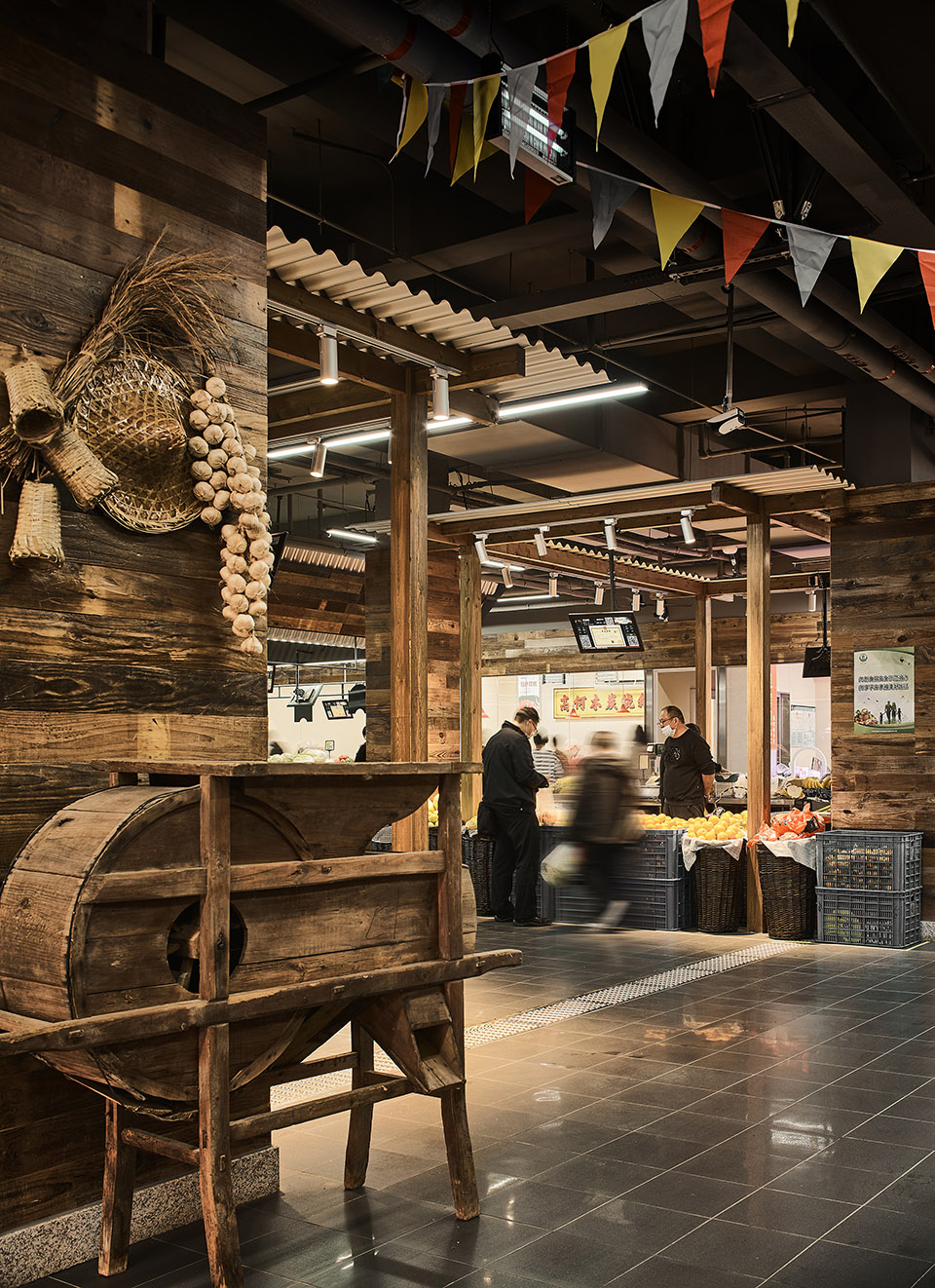
改革开放初期,中国在农村和城市恢复了曾被视为“资本主义尾巴”的农贸自由市场。饱受短缺经济困扰和国营菜店冷落的老百姓,以一种欣喜的心情接受农贸自由市场的到来。在这样的历史背景下诞生的产物先天决定了它是接地气的、最接近民众生活习惯形态的。
这些充满底蕴和生活气息的老菜场承载着许多宁波人的回忆,也记录着宁波这座城市的蜕变经历。在超市化菜市和各种买菜APP充斥的压力下,老菜场仍在坚守阵地。
In the early years of reform and opening up, China restored free markets in rural and urban areas which had been regarded as the tail of capitalism. The people, who had been plagued by shortage economy and neglected by state-run vegetable shops, welcomed the advent of free markets. With such historical background, the vegetable market was destined to be very down to earth and close to people’s living habits.
These old vegetable markets full of culture and vitality carried memories of many Ningbo people, and recorded the transformation of the city as well. Though under the pressure of supermarket and various shopping Apps, the old vegetable markets are still holding fast to the position.
▼入口,entrance ©朴言

双创背景下的时代,随着新消费层出不群,正在创造着菜市场的新时代,但菜市场到底该是什么样子?菜市场改造设计围绕“如何表现区域特有性菜场文化,如何通过设计导流消费群体”方向展开,在其围绕社区生活的方方面面完成自身的转型升级,并提供品类细分、专业化和品牌化的服务业态,发展成为一个承载起购物、体验、社交、教育功能的复合场所,体验性、文化性与休闲性同步发展,“以满足人的需求为出发点”的和谐状态。
Under the background of mass entrepreneurship and innovation, as new consumers emerge, a new era of vegetable market is being created. But what should a vegetable market look like? Renovation design of the case is about how to demonstrate the unique regional market culture and how to attract more customers by design. It is updated by taking every aspect of community life into consideration, and provides detailed, professional and branded service, which has been developed into a compound place with shopping, experience, social activity and education function. In this way, experience, culture and leisure synchronously developed, to meet the harmony of taking people’s needs as starting point.
▼项目内景,interior view of the project ©朴言
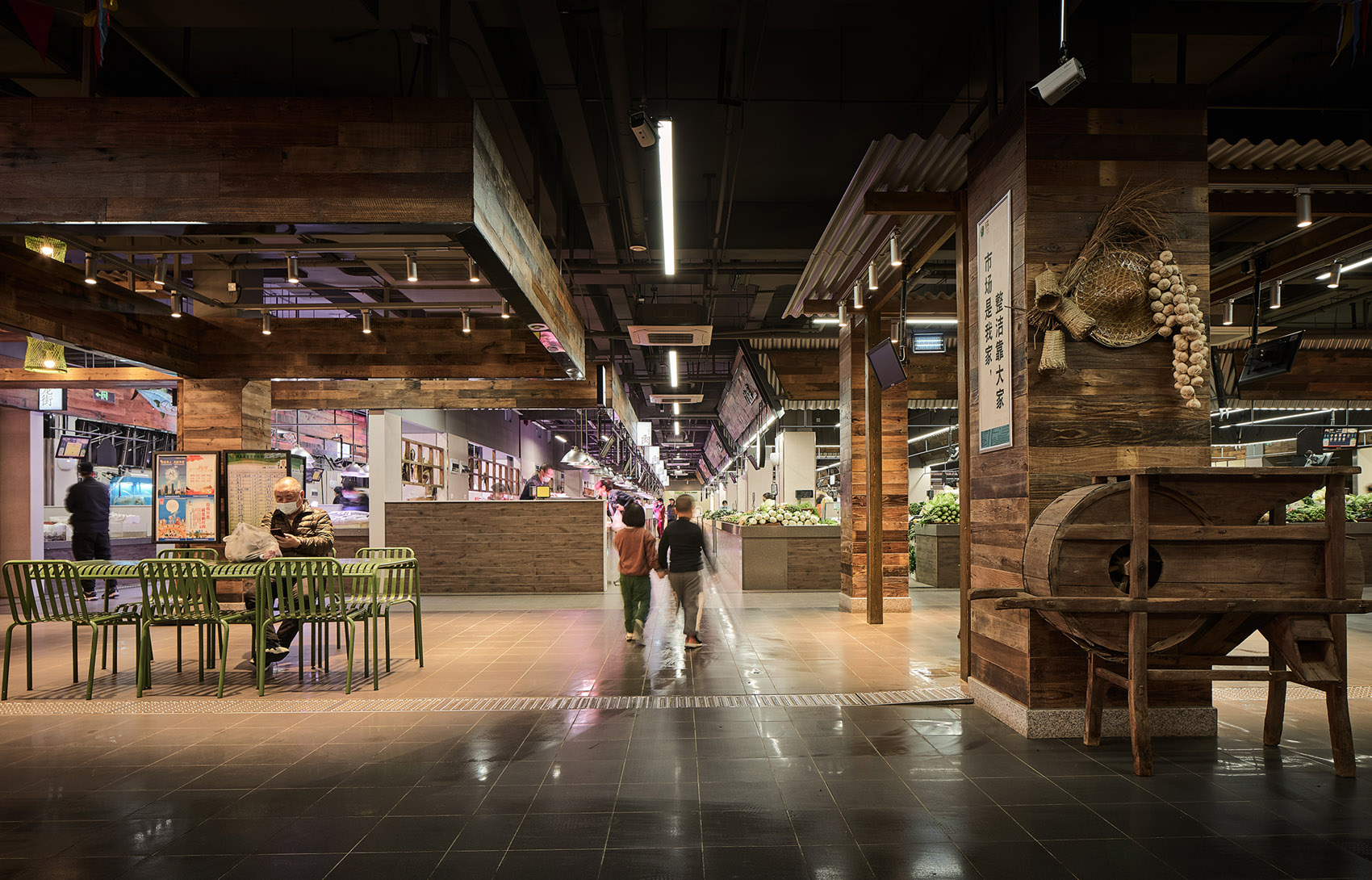
在设计中,我们会为自己预设要服务的群体,去考虑他们的感受并服务于他们的物质、情感和精神需求。而这次和商贸合作的菜场项目,则使这些预设群体有了更明确的身份——买卖双方以及运营方。菜市场拥抱了每天生活中热心喧嚣的普通人,也拉近了当下陌生人面对无处不在的社交所需要的那一份距离感。越了解空间使用者越能发现问题,这就像是一场博弈,运营方要低投入、易维护、好管理。经营者要实用性、展示性、便利性。顾客要整洁、方便、有氛围感。越了解对方越要糅合处理。虽然空间在许多人眼里好像只是空间而已,但在这个千万种情境设想和代入的过程中驱动自己的力量却恰恰是心底对探究、设计的坚持。
During designing, we’ll predetermine kind of groups, to whom we provide services and consider their feelings in order to better satisfy their physical and emotional needs. As for Fuming market, we learn definite identities for the groups, that are buyers and sellers as well as operators. A vegetable market embraces every ordinary person who leads a noisy but enthusiastic life, and shortens the distance between them on daily social interactions. The more you know about space users, the more problems you’ll find. It is just like a game: operators need low investment, easy maintenance and good management, vendors call for usefulness, good displays and convenience while customers need cleanness, convenience and good atmosphere. The more you know about each part, the better you could handle with it. Although space seems to be just space in the eyes of many people, the driving force of us in the process of imaging thousands of situations is exactly the persisting in exploring and designing from the bottom of our heart.
▼菜场内的特色农具、渔具装饰, decorative farm implements and fishing tackle in the market ©朴言
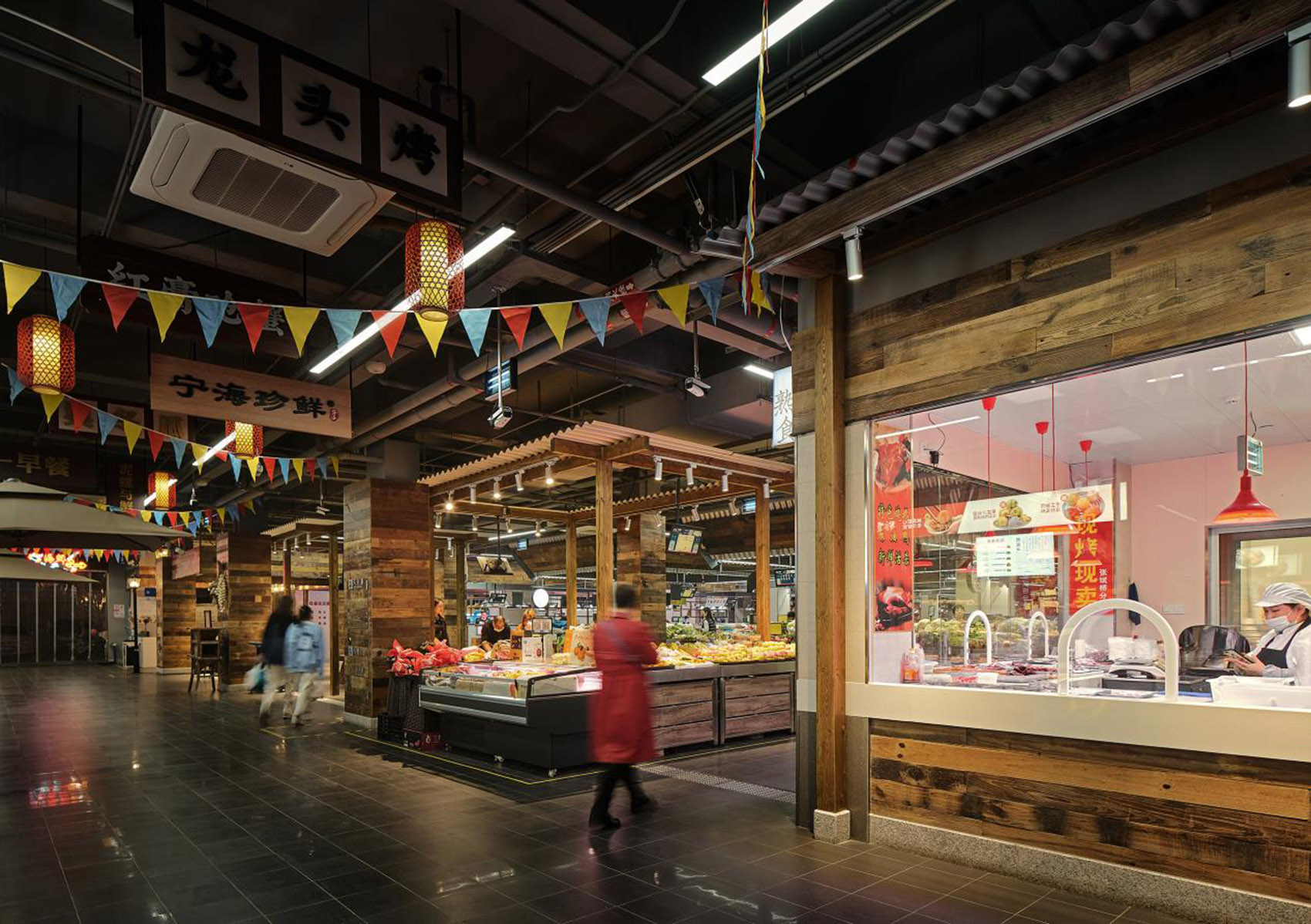
▼贩卖各式蔬果的摊位,a stall selling all kinds of vegetables and fruits ©朴言
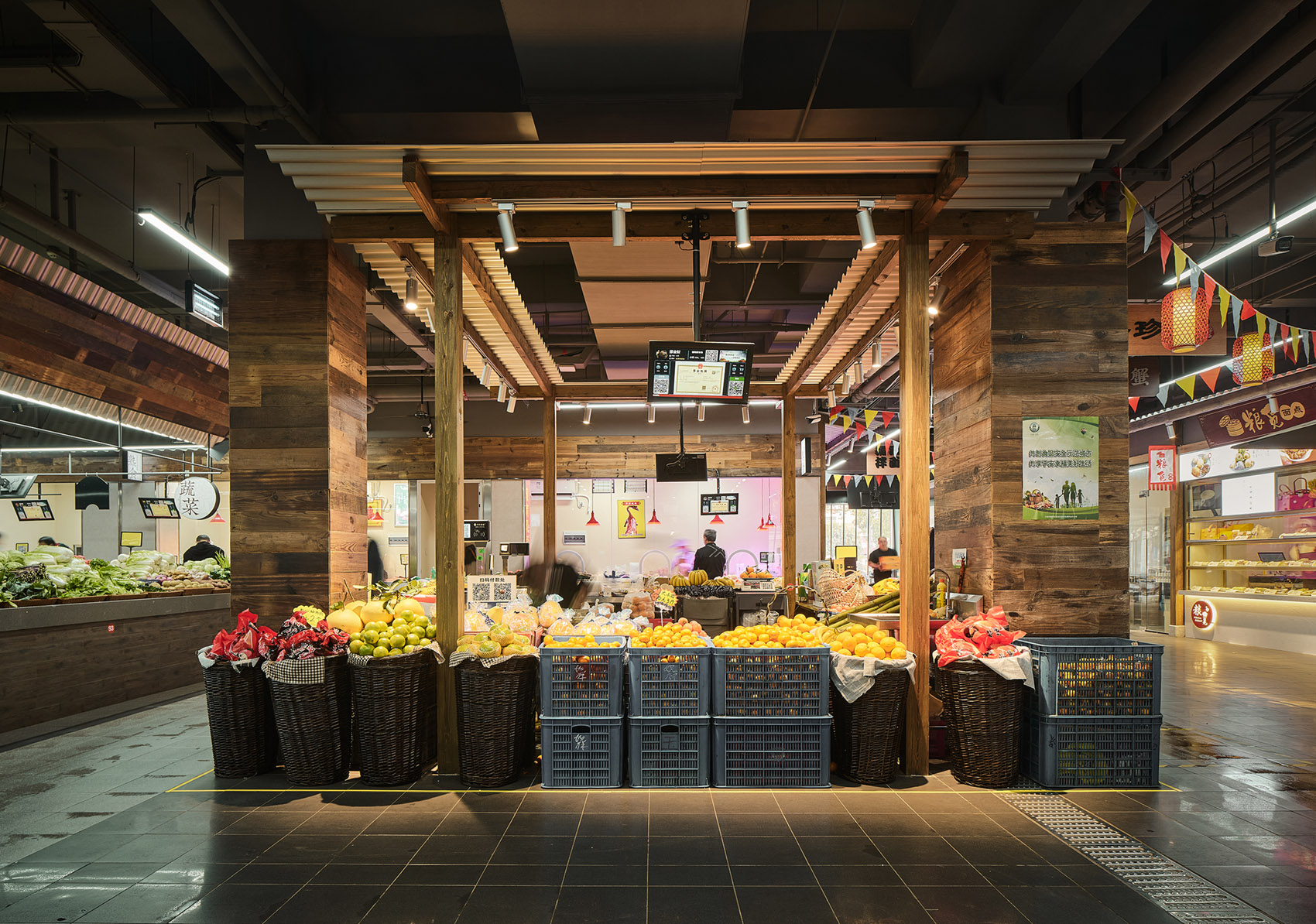
深入中国不同城市的菜市场文化进行拍摄考察,可以看到一股子卖劲的摊农和形形色色消费者间的交融、碰撞,也可以发现在菜市场里的人,他们自己是如何看待现状的,对菜市场整改的期望点又是在哪里。
作为设计方,我们需要有极强的同理心和洞察力,去发现他们的痛点,用好的设计去解决。就我们这次项目所在地宁波而言,我们发现菜市场的普遍形态都是完整的大空间,里面是狭窄的通道,脏乱的菜摊,老旧的设施,地面上湿漉漉的泛着腥臭味的滴水,包裹着不同的业态,呈现出被围合的封闭内向的状态。为打破这种封闭性,由此提出了距今1100多年历史的宁波鼓楼沿“街巷”的概念,这一概念反映在菜市场中,带给菜市场的是更开放的商业活动。同时在空间上设计多个出入口,为消费者提供多个流动动向上的选择,建立菜场与城市的互动。
By taking photos and investigating the culture of many vegetable markets in different cities of China, we see the blending and collision between hard-working vendors and all kinds of consumers. We also find out the point of how people view the current situation and what they expect for a better place there.
As a designer, we need insight and a strong sense of empathy to find their sore points and then solve them through a good way of design.As for Ningbo where the project is located, we found that the general image of vegetable markets is of a complete big space with narrow corridors, dirty stalls, old facilities and wet ground with smelly water, covering different business formats, presenting an enclosed state. In order to break this closure, the concept of “streets and alleys” along the Drum Tower of Ningbo with a history of more than 1100 years was proposed, which brings more open commercial activities in the market. At the same time, there are multiple entrances and exits for consumers, and thus establishing rich interactions between the market and the city.
▼摊位中的人行道,sidewalk between boothes ©朴言

▼街巷主题的摊位,street-shop themed stall ©朴言
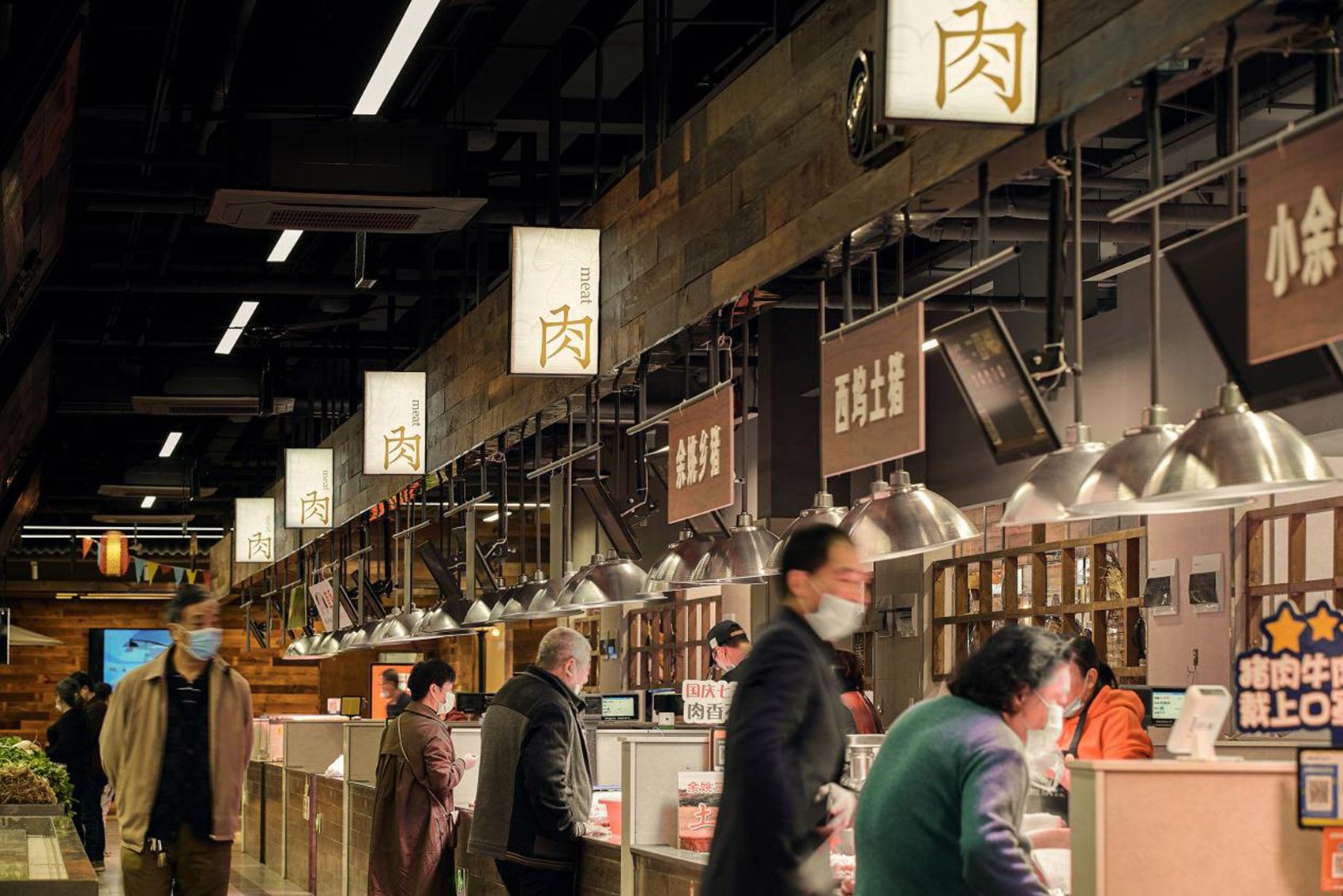
福明以福明桥得名,原以当地的吉利话命名,寓意幸福、光明。“福明,福先行”,设计从“福”100+存在形式的字符里获得了直接的装饰图案灵感和气氛营造点,让中国人的福文化融入菜市场。摊位设计延伸到传统文化中“四水归堂”的建筑表现手法,引用宁波天一阁“天一生水”的理念,把传统当地四合院四水归堂式的屋檐作为摊位门楣装饰,承载“天人合一”的理学思想,在江南的文化里,寓意着天财纳福,给到商户也是一种归家的重要象征。
Fuming block is named after Fuming Bridge, which means happiness and brightness according to the local auspicious words. Fu goes first in the word Fuming, thus we have got our inspiration of decoration directly from more than 100 kinds of Chinese character Fu, combining the Chinese blessing culture into the vegetable market. The idea of “four water to hall” from traditional culture is applied in the booth design. With the connotation of Ningbo Tianyi Pavilion, the designer uses the local traditional courtyard roofs as booth lintel decoration, which bears a theory of “man in one with nature”. In traditional Jiangnan culture, it is also a significant symbol of gaining fortune and luck, giving the vendors a sense of home.
▼将极具中国特色的装饰图案融入菜市场的视觉设计, integrate the decorative patterns with Chinese characteristics into the visual design of the market ©朴言

我们把传统艺术、在地文化和最大众材料相结合的方式,将菜场重新解构成为多个独立菜摊存在时,我们发现,菜场有了更大的探索空间。
When we combine traditional art, local culture and the most popular materials together, so as to re-construct the market into multiple independent stalls, we find that there are more to explore for the market.
▼室内蔬菜区,vegetable zone ©朴言
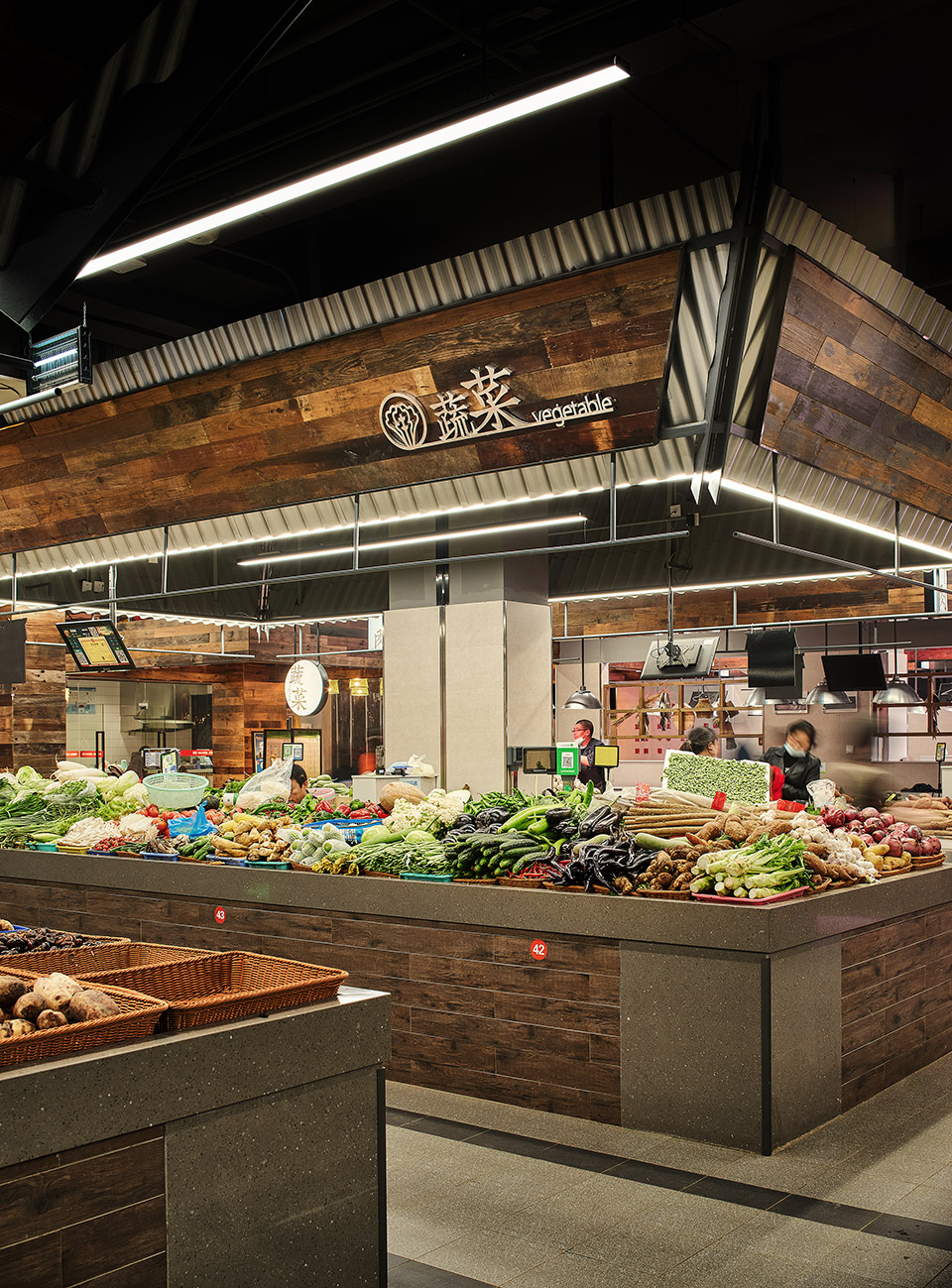
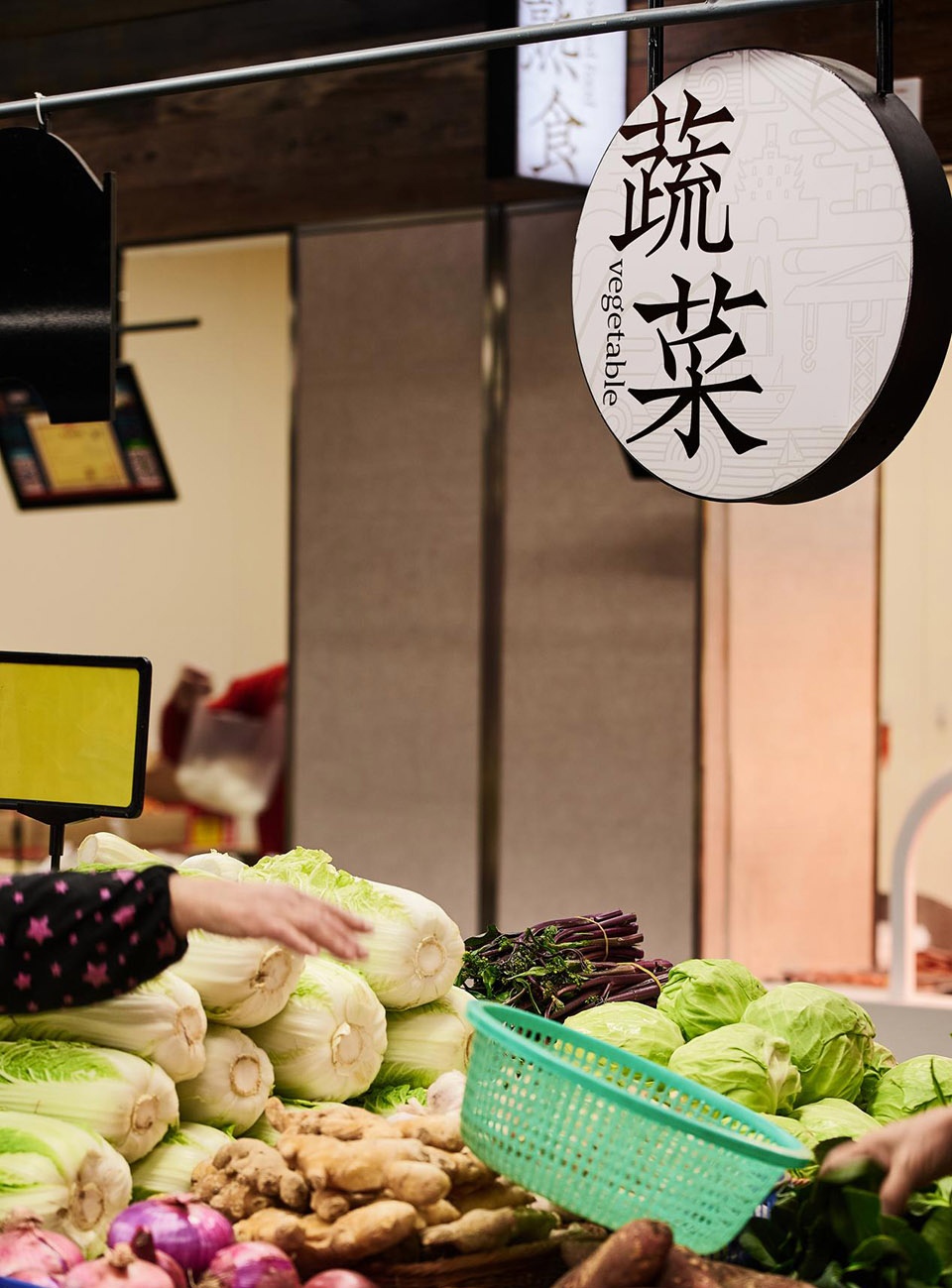
在平面布局上,项目将改造前的空档面积进行压缩,打造街巷式平面布局,形成浓缩地方特色的美食街区(干区)和独具滨海城市特性的水产街区(湿区),营造街市感,并将蔬菜、肉品、豆制品等其他摊位区块化,将每个品类通道都以特色的街巷主题进行贯穿,植入沉浸感和体验感。不同区域的商品在有序和无序中陈列着,由此产生了菜场中小尺度市集的景象。
As for layout plans, the designer compresses the spare areas and transform them into streets’ type, thus forming a food street with local characteristics (which is dry area) and a unique aquatic street with coastal city characteristics (which is wet area). And different kinds of booths for vegetables, meat, soy products and so on are blocked, which seems like street shops. Each corridor represents different category of food, providing highly immersion and experience. Goods from different areas are displayed in order and disorder, resulting in the scene of a small-scaled bazaar in the vegetable market.
▼室内肉品区,meat zone ©朴言
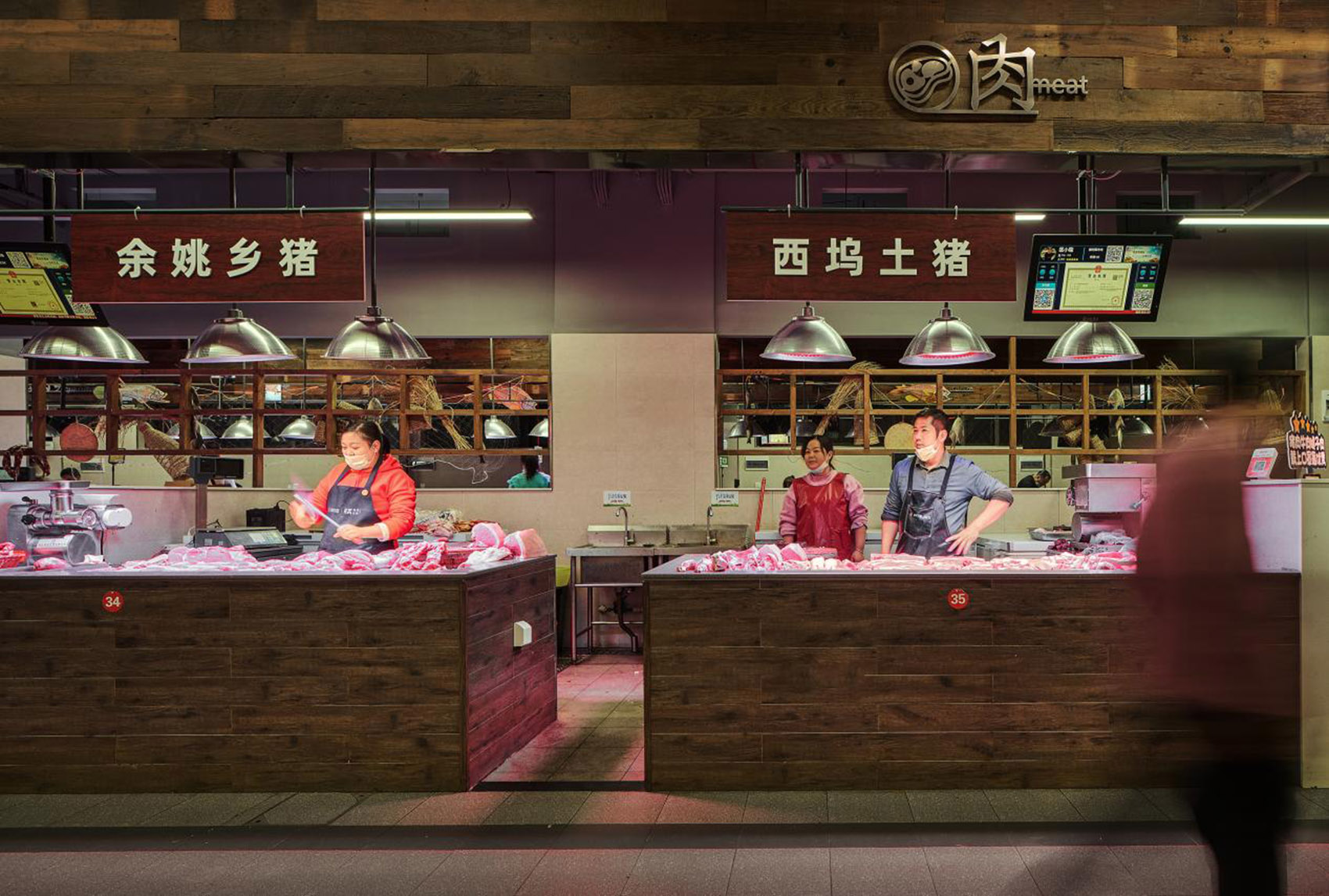
设计形态的背后有着清晰的结构逻辑,用质朴的手工艺、接地气的事物来加强视觉效果。
海鲜是福明菜场主打的特色产品,设计打造的“活龙街”是菜场内最有地方特色的一条海鲜街,这条街的命名来源老宁波人的方言词汇,专用来形容海鲜透骨新鲜,充满了东方海港老宁波的味道和记忆。木质窗格和渔具的组合还原了渔民出海回来晒海货的家常氛围,使菜场变得亲切有叙事性。在顶部结合当地非遗文化手艺人的鱼灯做了大量“鱼”的造型,色彩纷呈、大小不一,加强了海鲜品类的识别度和文化性。将传统非遗文化植入百姓出入的菜场,不止是设计,更是生活。
There is a clear structural logic behind the design form, and the visual effect is enhanced by simple handicrafts and down-to-earth things.
Seafood is the main featured product of Fuming market. The “HUO LONG” street is designed to be a seafood street which has the most local characteristics in the market. The name is derived from the dialect of old Ningbo people, which is specially used to describe the freshest seafood, recalling the taste and memory of the old harbor—Ningbo city. The combination of wooden panes and fishing gear restores the usual image of fishermen drying seafood after returning from the sea, making the market intimate and narrative. A large number of fish-typed lamps at the top of the street are made by local intangible cultural heritage craftsmen. They are of various colors and sizes, enhancing the recognition and cultural attributes of seafood categories. It is not only design but also life to implant traditional intangible cultural heritage into the market.
▼顶部悬挂的鱼型手工艺纸灯,fish-shaped handicraft paper lamp hanging on the top ©朴言
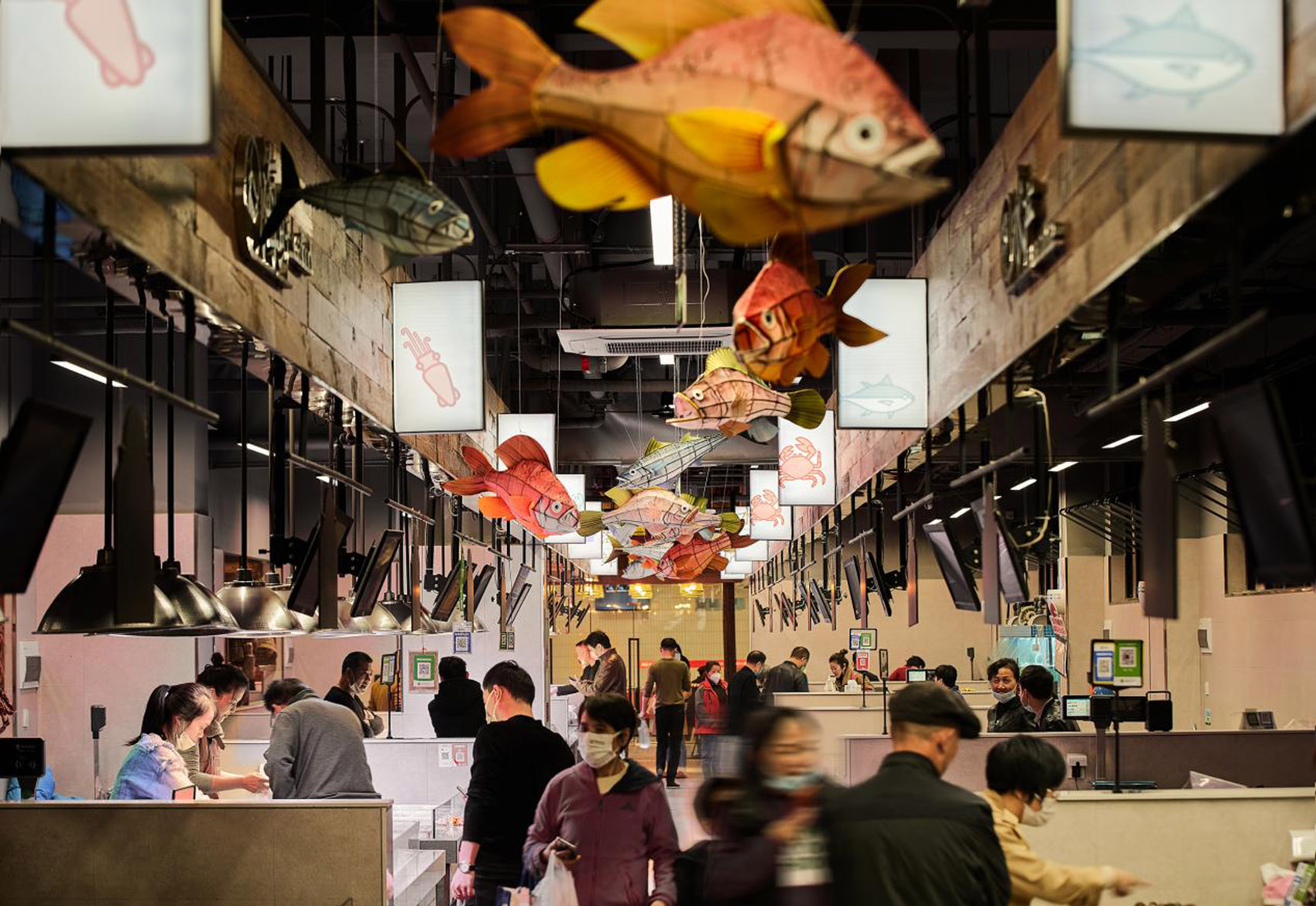
▼鱼型手工艺纸灯与霓虹招牌,fish-shaped handicraft paper lamp and neon signboard ©朴言
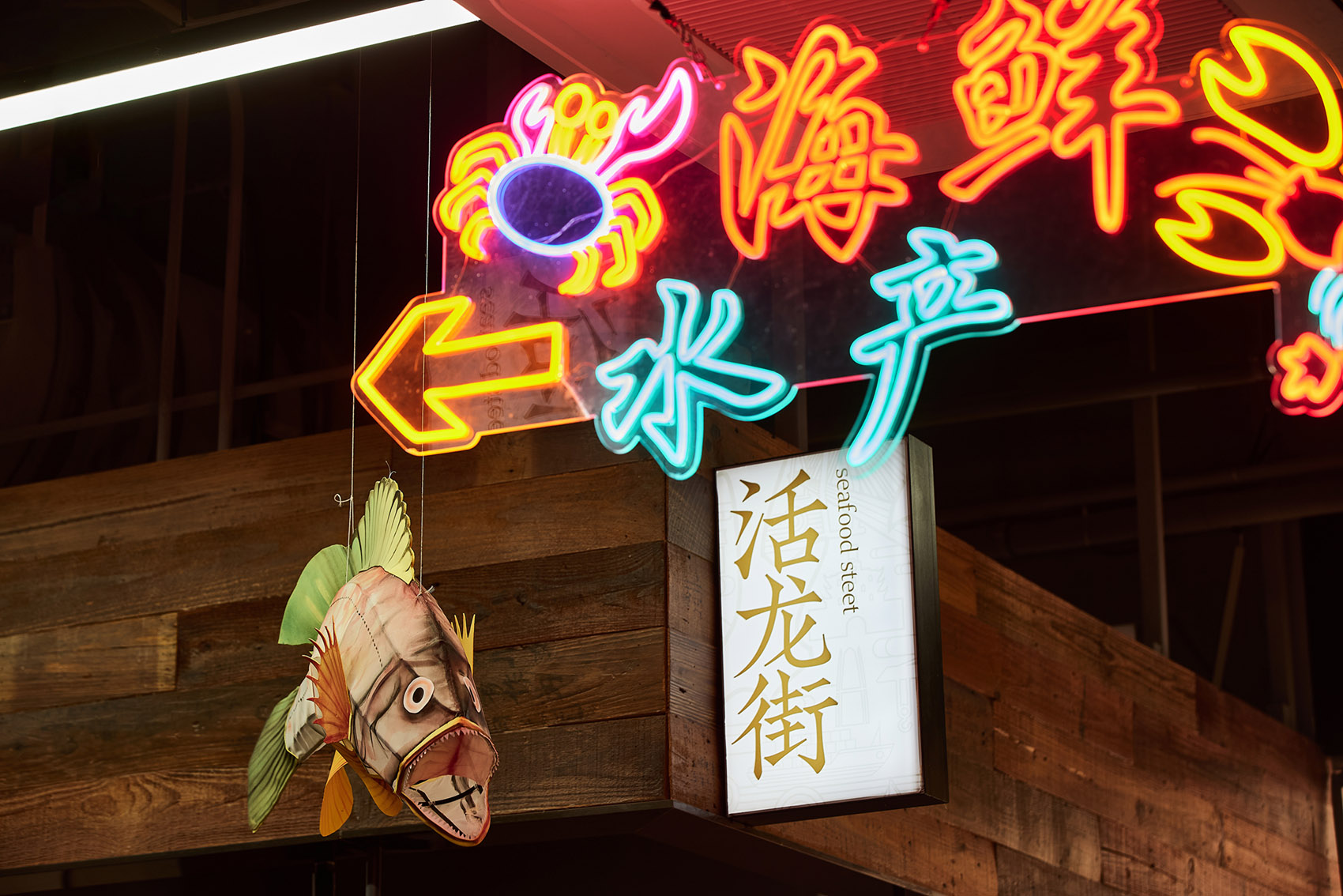
老宁波的记忆离不开宁波的特色美食,从汤圆、灰汁团、糯米槐等四时之味,到冰糖甲鱼、腐皮包黄鱼等传统之味,再到龙头烤、牛肉细粉、大饼油条等市井之味,无不牵动着宁波人敏感神经和深沉的怀旧之情。知味街的设计围绕乡情展开,老木头构建起了整个知味街的框架,天然的年轮肌理,满载时间的沉淀,质感温润,给人亲近感。将代表着宁波符号的美食招牌融入在空间内,给顾客很强烈的代入感。
福明菜场内部还特别设置了公共休闲区,为来往的人提供休憩的场地。八仙桌的再现拉回了老一辈人的记忆,也契合当下年轻人追捧的复古热潮。在项目落成后,我们惊喜的发现,这里意外成为了菜农孩子们等待父母收摊回家的游乐场所,围坐在一起谈笑、一起嬉戏。
The memories of old Ningbo people can not go without the characteristic food. Whether it is four-season flavor such as sweet dumplings, gray gnocchi, glutinous rice with locust, or traditional flavor such as steamed turtle in rock sugar soup, yellow croaker wrapped in dried bean sheet, or market flavor such as dried bummelo, beef with vermicelli, fried dough stick and clay oven rolls, all touch Ningbo people’s heart and deep nostalgia. The street is designed by using old wood as the frame. The natural texture of growth rings and the deposition of time from the wood make it warmer and closer to people. Signboards of Ningbo symbols in the space also give customers a strong feeling of being there.
We also set up a public leisure area in the market to provide a place for people to rest. The old-fashioned square table for eight people brings back the memory of the elder generation, and also meet the need of chasing vintage chic for young people. Upon the completion of the project, we are surprised to find that it unexpectedly become a playground for the kids of stall owners to chat and play together while waiting for their parents to go back home.
▼老木头构建的框架,old wood as the street frame ©朴言

灯光对于福明菜场,扮演着一个很重要的角色,为了不让菜品易被干枯,规避了具备更好菜品呈现的射灯的使用,根据不同区块不同功能的光源需求,采用了放光源、装饰光源、引导光源和特殊光源,呈现不同产品摊位的需求化和差异化。为了解决内部气味问题,吊扇灯和空调配合使用,让室内的冷空气均匀流通。在装饰材料上,菜场内大量使用旧原木、瓦楞板、水磨石等怀旧复古元素,以古为新,拒绝过新的现代装饰材料,同时把具有老宁波独特的民俗风味风貌的生产工具、年代图像、特色材质作为空间的装饰装点,创造出一种宁波特色的在地氛围。
Light plays a very important role in Fuming market. The use of spotlight is abandoned. Even though it makes better effect on the food, it also dries food easily. Instead, we use emission light source, decoration light, guidance light and special light to meet different needs of the booths. In order to solve the problem of indoor bad smell, ceiling fan lights are used in conjunction with air conditioner to ensure the whole space airy. As for decoration materials, retro elements such as old log, corrugated board and terrazzo are extensively used instead of new modern materials. At the same time, a lot of tools of production, old time pictures and specific materials with unique characteristic taste of Ningbo history are applied in the space.
▼菜场内大量使用旧原木等怀旧复古元素, retro elements such as old logs are extensively used inside the market ©朴言

对于更深层次的菜场研究设计,加强空间使用跟摊位标识更好的融合,以及富有识别性,仍在不断尝试。在满足实际需求的功能上融入本身元素和得以挖掘的文化,与此同时做出新和旧,坚持和改变之间的取舍,用现代化的设计手法表现菜场之美,延续被遗忘的传统。
Moreover, the design team is still trying hard to strengthen a better use of booth space with the sign, and make it much easier to be identified. They want to put in more cultural elements on the base of functional needs, and make trade-offs between old and new, as well as persistence and change. They hope to show the beauty of a vegetable market and continue the forgotten tradition by modern design methods.
▼装饰性的木质窗格和渔具,decorative wooden panes and fishing gear ©朴言
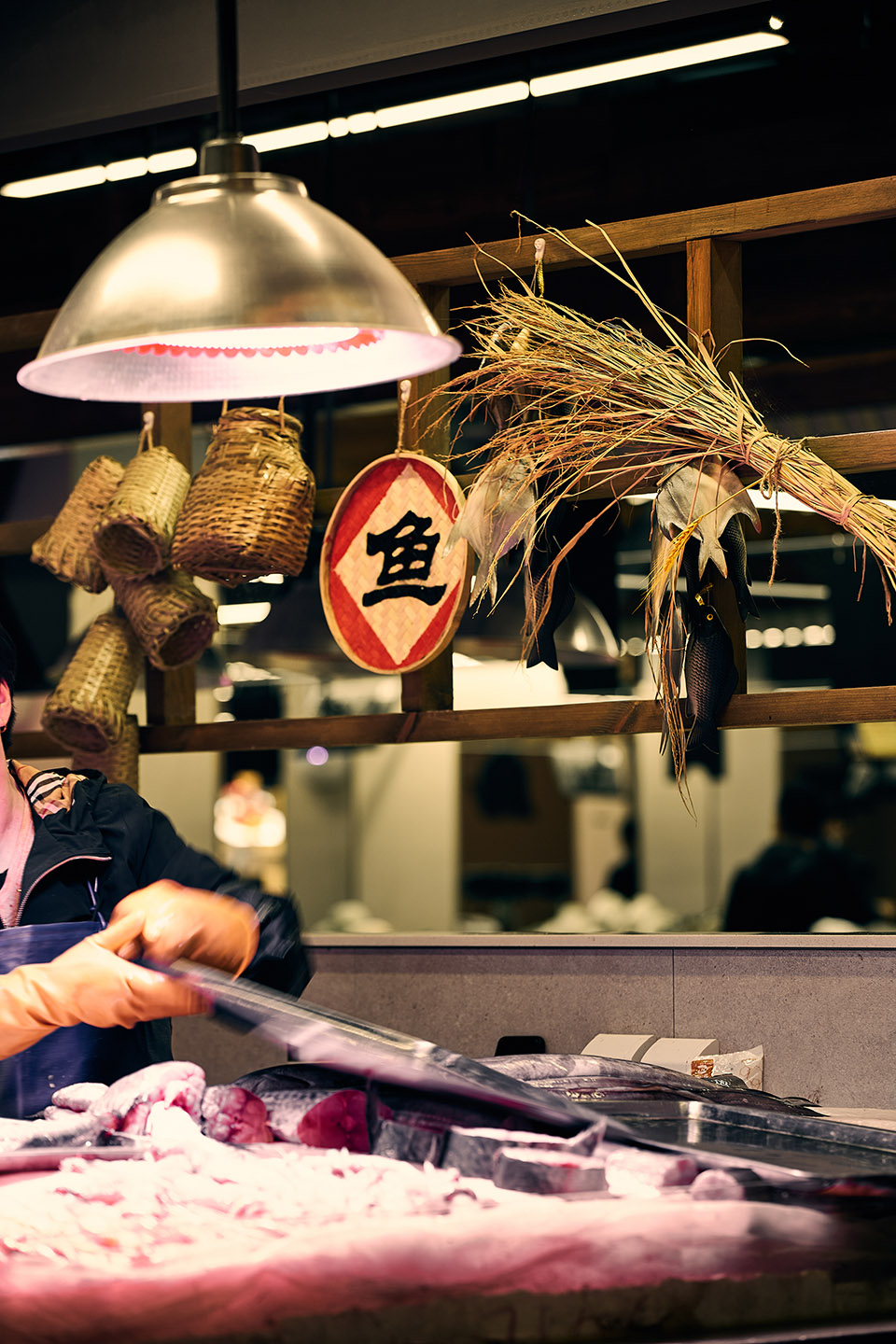
福明菜场里独有的暖光,霓虹光,古老又绚烂的色彩。空气中充满了旧时光的味道,慢慢的节奏,慢慢的生活。小手牵着大手,大手挎着菜篮,一起挑着生鲜果蔬,把人和人之间的连接温柔的放大。通过用材的巧思,铺贴上的撞色与室内灯光的微妙变化,整个菜市场透着雅俗味和烟火气。知道你自己是从哪里来的,这就是菜市场改造设计的意义。
There is warm light, neon light, ancient and gorgeous color in Fuming market. The air here is filled with the smell of old times, gentle pace of life. Imagine that parents hold the hands of kids, and they themselves carry a vegetable basket and buy what they want. Through the exquisite use of materials, contrast color and subtle change of indoor light, the whole market is elegant and down to earth at the same time. To know where you are from may be the meaning of this vegetable market renovation design.
▼顶部的装饰灯,decorative lights under the ceiling ©朴言
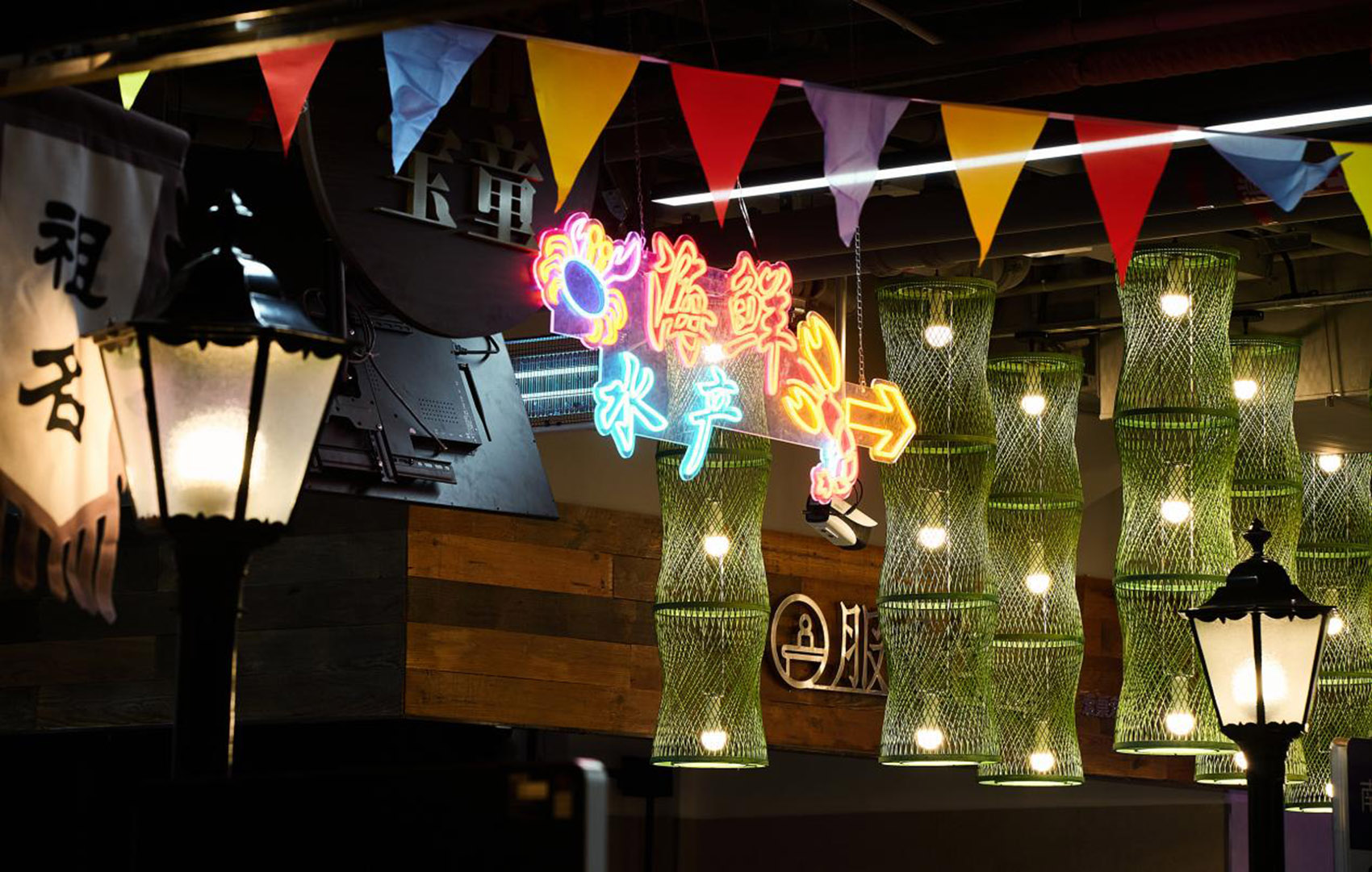
项目名称:城市更新下的福明菜场新思考|东海之滨的烟火气、人文味 项目业主:宁波商贸集团 建筑面积:7000平方米 项目地点:浙江宁波 完成时间:2021.09 空间设计:启仓设计 主案设计:毛赟 参与设计:郎帆、陈贝(软装) 深化设计:华汇工程设计集团 视觉设计:鲲麒设计 施工单位:建工建乐 运营单位:缤纷&金达利开发集团 摄影师:朴言 主要建材:瓷砖 人造石 钢架 老木地板 涂料
Project Name: New thinking of Fuming market under the urban renewal| A Real Human and Humanity World on the shore of East China Sea Project Owner: Ningbo Trade Group Construction Area: 7000㎡ Project Site: Ningbo, Zhejiang Completion Time: Sep,20 Architectural Design: Qicang Design Chief Designer:Mao Yun Team Member:Lang Fan、Chen Bei(Soft Decor) Construction Design: Huahui Engineering Design Group Visual Design: Kunqi Design Construction company: Ningbo Jianle architectural construction Engineering Co.,Ltd Operating Organization: Binfen&Jindali Development Group Photographer: Pu Yan Main Material: Ceramic tile, Artificial stone, Steel frame, Old wooden floor, Coating
